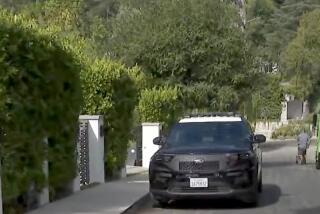Corona Copes With Gang Tensions : Rivalry: An influx of Orange County gang members has the former citrus town’s homeboys bristling, but so far it’s been just a war of words.
CORONA — “OC Rules” is scratched out and painted over with “Crown Town” along the “Alley of Hell,” a back street near Paseo Grande and 6th Street that bears the scars of gang rhetoric.
On the alley’s walls and fences, Corona’s well-established Latino gangs constantly hurl spray-painted insults in a war of words with imperialistic homeboys from Orange County interested in annexing more turf.
Two years ago, when Corona’s population boom was at its height, Orange County gang members began moving into the former citrus town, raising fears of violence in neighborhoods identified as gang territory. So far, the only sign of conflict has been highly stylized graffiti.
“We have a gang population, not a gang problem,” said Corona Detective John Marshall. “Even though they have the propensity for violence, there hasn’t been any violence.”
But, Marshall warned, “that could change. That could change any day. All it takes is just one incident.”
As a result, city officials have kept close tabs on the situation, concerned that if nothing is done to ease tensions between the gangs, the exchange of words will turn into an exchange of gunfire.
Corona has five gangs that have been around for generations, even back to the days when the city was called the Lemon Capital of the World. Like their counterparts in other cities, Corona’s gangs are very protective of their barrio, or neighborhood.
“They consider themselves warriors, or soldiers, to their community,” Marshall said.
The root of the current gang conflict took hold as a tide of families moved to Corona from Orange County in pursuit of affordable housing. With them came teen-agers belonging to Orange County gangs.
“The ability to move there has increased,” said Deputy Probation Officer Colleene Hodges, who supervises Orange County’s Gang Suppression Unit. “It’s not like they’re moving to just anywhere. These are areas that they can afford and be away from their old neighborhoods.”
But what many parents fail to realize, Hodges and Marshall say, is that teen-agers can bring their gang ties with them.
“The parents can move to Timbuktu, but it’s the kids’ choice” to retain their gang ties, Marshall said. “They tattoo it on them. Their loyalty is to that gang. . . . They bring with them their same habits or attitudes.”
These habits include the standard gang activities, such as parties, cruising, drinking and, most notably, the spreading of graffiti, which immediately came to the attention of city officials and police two years ago.
“Many (Corona gangs members) say, ‘We live here now. We’re not going to see Orange County graffiti here,’ ” Marshall said. “For the traditional Hispanic gangs that have been in Corona for generations, that’s an offense to them.”
“A lot of guys from Santa Ana, they disrespect Corona,” said an 18-year-old Corona gang member who identified himself only as Gunner. “That ain’t cool. That’s not cool, man.”
So far, city officials say, they have been able to defuse gang tensions with two cleanup programs that erase graffiti, sometimes within 48 hours. Last year, the Corona Chamber of Commerce embarked on one such project in Corona’s redevelopment areas. The city has a similar program in residential neighborhoods, and a “graffiti hot line” was started so that defaced areas could be reported.
“The graffiti is the beginning of it,” Hodges said. “That’s the open challenge. To ignore it is a mistake, because eventually you’re going to have action.”
Between November, 1989, and August, 1990, the Chamber of Commerce reported, 371 locations within community redevelopment areas were cleaned up. Later this month, the graffiti removal program will expand citywide, with $40,000 in city funds.
In addition to graffiti removal, two police officers have been assigned by city officials to patrol Corona High School and Centennial High School. The officers spot gang members who have been involved in criminal activity, which, so far, has been limited to vandalism and petty burglaries.
When a gang member is identified, an officer meets with the youth and his parents to try to get him away from gangs and into school associations.
Today, there are some signs that Orange County gang members have backed off from the graffiti war, Marshall said. Instead, he said, they are commuting back to Santa Ana, where they still have ties in their old neighborhoods.
Marshall doubts that street gangs from Santa Ana or Los Angeles would be able to establish themselves in Corona, where, he said, gang members tend to be more subtle. Outsiders, Marshall added, might stand out, depending on their gang traditions.
“Very few people, if any, fly colors in this town,” said Corona Police Lt. Roy VanderKallen.
Even the 18-year-old gang member, reflecting on the increase in Orange County homeboys, said he has noticed that things have been stable and that the newcomers have been lying low.
“First it was one guy, then two or three guys, then crowds,” Gunner said. “They start throwing their finger signs and hand signs. It’s ridiculous. They look like cartoon characters.”
But for now, he said, “the guys from Santa Ana are really chilling out. The older guys are trying to make peace.”
More to Read
Sign up for Essential California
The most important California stories and recommendations in your inbox every morning.
You may occasionally receive promotional content from the Los Angeles Times.










